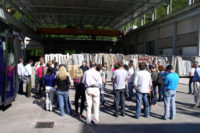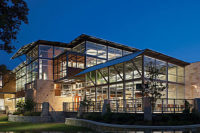And even in a down economy, many homeowners are still spending money on their residences. But when doing so, they want to make their investment worthwhile. To create a one-of-a-kind look, they are using stone and tile products in unique applications in their home. In some cases, they are opting for re-used or re-claimed stone and tile, which brings character to the design as well as helping to preserve the environment.
Husband-and-wife architects German Brun and Lizmarie Esparza of DEN Architecture in Miami, FL, have discovered that their overall green design philosophy is extremely manageable and still enables them to create unique designs for any client’s request. Focusing mainly on texture and color palettes, they believe that creating a series of “zones” in an interior helps with the selection of materials for each area. “These zones become areas of transition from more public spaces to more private ones,” said Brun. “For instance, the entrance foyer should be designed with a rougher texture, and the bedroom area with a more smooth, delicate and intense texture.”
Speaking on current trends, the architects said they are seeing increased use of large-format tiles as well as porcelain tile varieties that resemble the look of exotic natural stone. Moreover, they are not only selecting new material types, but they are also presenting them in a different way to develop a signature look.
Another observation that the architects have made is a return to darker tile colors. “At one point not too long ago, particularly in South Florida, everything had to be white or beige,” said Brun. “Now, with our guidance of course, clients are starting to explore a wider range of options from all kinds of hues and tones. Darker colors are no longer discarded, and some adventurous clients are even asking for stronger colors. As long as it’s in balance with the overall design aesthetic, we are delighted to include un-conventional colors, textures and tones. It’s what makes our projects stand out, and our clients happy.”
Spatial experiences
For a recent project, the architects at DEN Architecture transformed a compartmentalized old-fashioned apartment in Miami, FL, into a modern collage of spatial experiences. The living area, kitchen and master and guest bathrooms were all redesigned with an assortment of stone and tile products. With the goal of designing and building a contemporary remodel of a 1970s apartment in record time — along with a low budget — Esparza stated that this redesign was completed with “surgical precision.”
According to the architects, Italian porcelain tile from Imola’s Maxima Rainbow collection was used in the living room and kitchen to bring together the accent colors of the overall design. “We needed a [material] that incorporated reds, browns, a bit of white and grays,” said Esparza. “Imola’s tile was the only product we could find that featured that exact specification.” Although this tile was used in both the living room and the kitchen area, it served a different purpose in each space.
“In the living room, we needed a large focal point to serve as the entrance backdrop, and balance the oversized television console,” said the architect. “However, in the kitchen we needed a textured color background to contrast the white upper cabinets.” Because of its beautiful exotic pattern, the tile allowed the architects to bring the entire design together and incorporate the color palette the client requested.
A distinctive feature wall was created in the living room with the large-format Imola tiles. With waves of vibrant colors, the tile pieces appear as a work of art on the wall — contributing to the overall clean contemporary feel of the space. The wall was complemented by the original coral stone floor tiles, which were restored and refinished. “We decided to reclaim this stone because it is beautiful material, and stone is much easier to re-finish and repair than porcelain or ceramic tile,” explained the architect, adding that the coral stone brought warmth and a rustic tropical atmosphere to the living room. “[But], matching the existing stone color, finish and pattern did prove to be challenging for us.”
In the kitchen, Imola’s Maxima Rainbow tile forms the backsplash and is a nice contrast to the stainless appliances and white cabinets. Additionally, quartz countertops from Compac was selected for the countertops and center island. While “Plomo” was featured on the perimeter countertops, “Chocolat” was employed for the top of the island.
“Since this material is considerably expensive, we decided to re-use the excess from cuts in the rest of the apartment,” explained Esparza. “So from the remnants of the kitchen countertop fabrication, we were able to salvage [material for] the countertops for the guest and master bathrooms.”
For the master bedroom, the architects desired a luxurious feel, and they selected large-format floor tiles to help achieve the chic look. “Some people believe that dark materials create a smaller-looking space,” said Esparza. “We don’t necessarily agree with that. The proper use of dark materials adds depth — which is why we employed Imola’s Nappa porcelain tile for the master bath and bedroom floors.”
Because the architects spent an abundance of time on site supervising the installation, they were able to complete this project within two months. “The client couldn’t be happier with the redesign,” said Esparza. “The American Institute of Architects also gave the project an award for Interior Design.”
Breaking expectations
The Andaz Hotel, located in San Diego, CA, has also recently undergone a redesign — including its guest baths, which feature a blend of stone and glass mosaics along with natural stone. Ted Berner and Dayna Lee, Principal Designers of Powerstrip Studio, worked directly with their client to create a sense of beauty in these spaces.
“The design goal for our guest bathrooms was transparency, which breaks the expectations of the typical bathroom,” said Lee. “The design effect offers a sense of large spaces and a certain sexiness. In addition, with all walls fully exposed, we desired beauty, which led to the choices of stone and tile from Hirsch Glass Corporation [of Cranbury, NJ].”
According to the designer, The Earth & Art collection, which consists of a stone and glass blend, was employed in the redesign of the guest bathroom to complement the high-end stone finishes already established in the space. “We wanted to find something that was both sparkling with glass, and velvety with stone,” she said. “These 1- x 1-inch mosaics offered subtle glitter and overt polish to our existing stone.”
While sourcing these patterns, many samples were considered before deciding on the Earth & Art blend of stone and glass mosaics. Lee also noted that she often designs with mosaics for both aesthetic and practical reasons. “I enjoy designing with mosaics since they provide permanent art with depth to the space,” she said. “This is art that one can enjoy in wet environments.”
Complementing the subtle earth tones of the mosaic shower walls are floor-to-ceiling travertine walls. The warm tones of the travertine further contribute to the overall look of elegance in the guest bath.
When it came to the installation, some thought had to be given to the mosaics. “Our most challenging design aspect of this project was how to tailor the transitions when they meet other finishes of other thicknesses,” she said. “Ted sharpened his pencils and tried multiple compositional variations. However, in the end, it is always the simple version that glides.”
According to Lee, Michael Kelly, owner of the Andaz Hotel, was also heavily involved with the design process, and oversaw the installation. “We also had a great general contractor and architect who were very careful, and kindly let us know when they have hit some challenges,” said the designer. “When we prepare more on the front end to resolve speed bumps, then there are fewer calls from the construction site.”
With the 45-room production schedule starting in February 2011, the guest baths, which averaged between 80 to 100 square feet, were completed by the end of April 2011. “Both the owner, Michael Kelly, my co-Principal Designer, Ted Berner, and I were so pleased with the result of the materials and everyone’s good work,” said Lee. “It feels like another very custom, very complete and exciting addition to our portfolio of rooms at the Andaz.”
Combining different elements
Sharon Brandt, Founder and President of Granite Connection, LLC of Potomac Falls, VA, recently took on a project where her client — a couple from Virginia — purchased their “forever house,” but were not completely satisfied. The couple didn’t love the kitchen, which was a huge problem because a family typically spends an extensive amount of time in the space. Addressing this, Brandt employed natural stone to give the space more of a personality.
“It was a large kitchen of more than 200 square feet of countertop, but the space lacked personality and warmth,” said the designer. She continued to explain that the overall design goal was to remodel the kitchen to make it more functional for a family with four small children.
To start, Brandt made the decision to cut the island down to expand the seating space to six people. “Before the remodel, the island was large enough, but had an awkward bar height that was not conducive to seat small children,” she said. “Once that was complete, we could see the real vision of the kitchen and how the high ceilings gave the space a lofty feel.”
With the client’s desire to have warm tones to fill the large space, the designer had to make sure each element stood out. As a result, color and texture were carefully considered before a final selection was made.
Saturnia granite — supplied by Virginia Marble and Granite of Chantilly, VA — was chosen for the new island countertop. The coloring and movement in the material brought an exotic feel to the space. In addition, Absolute Black granite was used for the perimeter countertops, and rough-textured natural stone veneer was employed for the backsplash. Both materials were supplied by The Tile Shop of Sterling, VA.
“The homeowners fell in love with the exotic Saturnia stone,” said the designer. “We used that stone for the island, but we wanted a more neutral stone for the perimeter, so the Saturnia could be the focal point.”
Noticing this stone for the first time at Coverings in Orlando, FL, a few years ago, Brandt noted that Saturnia is by far one of the most beautiful stones she had ever seen. “My suppliers and I walked through the Antolini Luigi exhibit and there was a slab of Saturnia on display in the convention hall,” she said. “We just had to have it. Since then, it has been one of our most popular stones at the shop.”
Because the Saturnia was an immediate favorite, not many other materials were considered. “I think I may have geared my client away from the stone veneer backsplash, if the kitchen was not so large,” said Brandt. “When using three different mediums of natural stone, you have to be careful not to make it look like the Flintstone’s kitchen.”
When redesigning the kitchen, which is approximately 1,800 square feet, the tile installer did encounter a challenging aspect. “Since the stone is thick, but also soft, cutting the outlets with this material was difficult for my installer,” said Brandt. “He had to be extremely careful and not rush the cut.”
In total, the kitchen remodel took about three weeks to complete. “However, we made sure the family had a functioning kitchen during this time,” said the designer. “This was important to this busy family.”
When the redesign was completed, Brandt posted the photos on her company’s Facebook page and received rave reviews. “All of the elements of this kitchen came together beautifully,” she said. “The three different stone elements featured in this space work extremely well together, mainly due to the large size of the kitchen. I have had several customers say, ‘I want that same look,’ but you need to have the right space to make it work.”
Pure luxury
With a “super minimalistic” design goal, Walid Wahab of Wahab Construction in Miami, FL, focused on the use of very fine materials to achieve a refined fashionable look in the recent design of a Miami, FL, penthouse. To create a minimalistic feel, the builder featured pure White Thassos marble from Greece and glass tile in the design.
The white marble employed for the flooring and accent columns in the penthouse create a rich lush feel in the space. In the media room, the floor consists of custom-cut slabs of the flawless White Thassos — with each slab cut to precise specifications for an exact fit.
“There is nothing more minimalistic in stone than pure extra White Thassos,” said Wahab. “It is extremely difficult to obtain large orders of this stone without blemishes; therefore we purchased a very large waste factor to enable us the option of choosing from the close-to-perfect pieces.” Since the order was large enough in quantity and quality requirements, Wahab and his team were able to go to the source in Greece to hand-select the slabs.
In addition to employing Thassos White marble in the design, Wahab also featured custom-colored glass tile in the master bath of the penthouse. Supplied by Ann Sacks, the glass tile was utilized as the flooring in the shower, and it was selected because of its translucency and similarity to the tones of the sea. “It was fitting to use this tile, since the surrounding ocean water is what defined the penthouse,” said Wahab, adding that White Carrara marble slabs from Italy were chosen for the shower walls.
Before making a final decision on the material palette, Wahab considered a composite of manmade White Thassos, which was made in China. “Constructed from real Thassos shavings, which are mixed with manmade materials and repaired into slabs, this guaranteed a white stone with no blemishes,” said the architect. “We found that this type of stone lost the natural depth of real stone and looked perhaps too fake.”
According to Wahab, many mock-ups were viewed, and samples of Thassos were rejected from many local and national suppliers. “One order worth hundreds of thousands of dollars was rejected upon delivery, as it did not match the approved control sample,” he said.
Construction of the penthouse was completed in approximately three years. “This 8,000-square-foot penthouse is admired by all, and well-known in Miami’s design community,” said Wahab. “It’s definitely one-of-a-kind for our city.”














